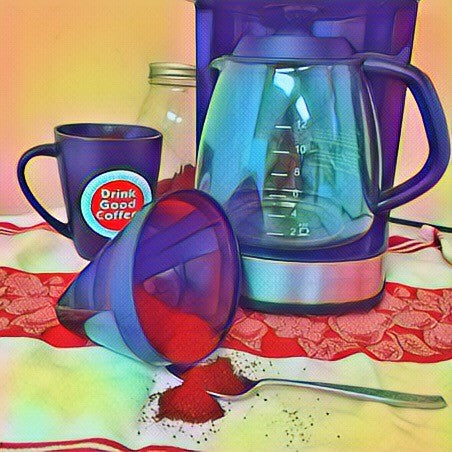
If you order your coffee pre-ground, choose ‘Foil Filter’
If you order whole bean and grind at home, grind just slightly coarser than medium
Most drip coffee pots can accommodate a reusable metal mesh, or foil filter, which eliminates the need to purchase paper filters. Nobody wants to wake up on a Sunday morning to find they can’t make coffee because they forgot to purchase filters! Foil filters are, in the long term, more economical, and better for the environment, as they can be used over and over again. Some even argue that a foil filter provides a richer flavor than a paper filter, as more coffee oils are allowed through to your final cup.
When using a foil filter, if you use coffee that is ground for drip/ paper filter, you may end up with some sediment at the bottom of your coffee cup. This is why we recommend just a slightly coarser grind for a foil filter, in order to provide good extraction but no grinds in your cup. Be cautious though! Too coarse of a grind will lead to a weak cup of coffee because the water will go through your grinds too quickly for proper extraction.
We’ve discussed some methods for brewing coffee through a drip coffee pot before. Although the previous article focused on using a paper filter, the method is pretty much the same. Read more by following this link.
If you’re still struggling to make a cup of coffee at home that meets your standards, try some of these more in-depth tips:
-
Check your water temperature. Older coffee brewers can build up mineral scale, which leads to inadequate temperatures for brewing. Water that is too cold cannot extract properly in the amount of time a drip coffee pot takes to brew coffee. The correct water temperature range is approximately 195-205 degrees Fahrenheit. Most coffee makers are programmed to heat cold water, so don’t add hot or lukewarm water to the reservoir. If you are still not maintaining a hot enough temperature, it may be time to replace your coffee pot, (or take this opportunity to try a different brewing method!)
Try using filtered water. Believe it or not, the “hardness” or “softness” of your water may be making your coffee taste different. Minerals, or chemicals used to treat your tap water, even if it is safe to drink, can alter the taste of a cup of coffee. You can filter it yourself with an at-home sink attachment or pitcher, or purchase pre-filtered water specifically for making your coffee.
Regularly clean your coffee brewer. Calcification buildup can affect flavor and the functionality of your coffee brewer. Run a 50/50 mix of water and white vinegar through the brew cycle once in a while to clear up any internal issues. Wipe down the water reservoir and regularly clean all pieces that are removable. This will keep your coffee free of outside flavors.
Try “blooming” your coffee. This means wet your grinds and let them sit for a few minutes before turning the coffee pot on. This can lead to better extraction, which means better flavor.
Don’t let your coffee sit on the heating element for too long after it’s been brewed. The space underneath your carafe is heated to keep your coffee warm, but sometimes it can overheat your coffee as it sits, leading to bitterness and burnt flavors. Try to brew your coffee and pour it to drink as soon as it’s done.
How to Brew Coffee Using a Metal Filter
-
Fill coffee carafe with water to desired amount
Pour water into water receptacle
Measure your coffee grinds. A good ratio is 2-3 level TBS per cup of water (adjust to taste)
Place metal filter into appropriate receptacle in the machine
Add grinds to metal filter
Pre-wet and allow coffee to bloom for a few minutes, if desired.
Close lid
Press appropriate button for your machine to begin brewing
Wait until it’s done dripping, then pour and enjoy!